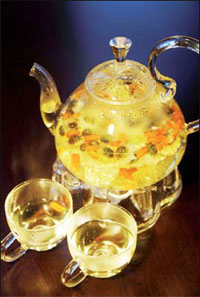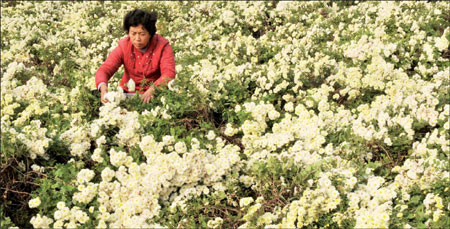Flower power
Updated: 2012-12-07 09:09
By Zhang Lei (China Daily)
|
|||||||||||
|
Above: A farmer picks chrysanthemums to make flower tea in Central China's Henan province . Below: Chrysanthemum tea is a traditional Chinese drink that can help people stay healthy. Photos Provided to China Daily |

A traditional drink for relaxation, chrysanthemum tea is also believed to have a host of health benefits ranging from detoxification to treating blurred vision
'While picking chrysanthemums beneath the eastern fence, my gaze upon the southern mountain rests." These are the words of Chinese poet Tao Yuanming (AD 365-427) from Drinking, one of his best-known poems, in which he describes a perfect retreat away from the bustling world. Chinese literati have long used the chrysanthemum as a symbol of humility and inner peace, and written about drinking tea made with the flower. Now, with moments of peace an increasingly rare commodity among China's urban sprawl, tea specialist Chen Wenhua has opened a chrysanthemum tea farm in a remote village in Jiangxi province, as a challenge to the modern world.
"In 2004 I spotted an abandoned ancient hydraulic rolling tea machine in Shangxiaoqi village and had the idea of setting up a tea farm here, shrouded in a span of camphor trees and meadowland, beside a winding brook," he says.
Eight years later, Chen's tea farm is a successful business and brings a steady flow of travelers to the village.
His yellow chrysanthemum tea sells as much as 10,000 yuan ($1,609; 1,227 euros) per kilogram, compared with 200 yuan a kilogram of the normal quality flowers. One reason is that the bulbs of Chen's flowers are much larger than usual and when boiled the petals remain intact for hours.
Chrysanthemum tea is one of the most popular flower-based Chinese tisanes. Only two species of chrysanthemums - morifolium and indicum - are fit for making tea.
Unlike green tea, which demands a strict process to get the best taste from it, the preparation of chrysanthemum tea is rather simple. Chrysanthemum flowers are steeped in hot water in a teapot or glass, often accompanied by rock sugar or wolfberries to strengthen the flavor. It is best to let the water cool slightly before pouring it over the flowers as boiling water can dissipate the flavor. This is left to infuse for a short while before the tea is ready for drinking.
High quality chrysanthemum tea should look transparent, bright yellow in color, and exude a floral aroma.
"Good quality chrysanthemum is not decided by the fertility of the land, but by its surroundings," Chen says.
"The Chrysanthemum is a short-day sunshine crop. If it is exposed to more than 12 hours of sunshine in one day, it won't bloom, so land surrounded by hills on every side that block the sun is perfect.
"The Chrysanthemum also needs water but its surroundings should not be too damp. I chose to plant in Shangxiaoqi village because the small brooks here produce the right amount of moisture for chrysanthemum."
Chen does not use fertilizer, but instead scatters the seeds of Chinese milk vetch. When the chrysanthemum starts to bloom, the milk vetch roots help to absorb nitrogen from the air. It is much more effective than traditional fertilizer, Chen says.
There are roughly four types of chrysanthemum tea in China today: Huangshan Mountain gongju, which literally means Yellow Mountain Tribute chrysanthemum, is the most famous; hangbaiju originates from Tongxiang in the Yangtze Delta; chuju comes from the Chuzhou area of Anhui; and boju from the Bozhou area of Anhui. Chen's chrysanthemum is a variant of Yellow Mountain chrysanthemum.
Chrysanthemums are usually harvested in November, when frost can stop the flower from fully blooming.
From Chen's experience, if it rains for more than four days, frost will definitely occur on the first clear day that follows. Chen's farm is dotted with haystacks as a protection against this.
"I browsed through more than a hundred traditional Chinese farming books to find a way to stop frost affecting the flowers," he says.
"We roll out the haystacks at dusk, then fire them up and let the smoke hover above the air for a while. This stops frost forming on the flowers the next day."
Chrysanthemums extract a lot of nutrition from the soil, so Chen divides his land into several sectors to rotate planting. When a sector is bare of chrysanthemums his workers plant vegetables for a year to help the ground regain its strength.
Chrysanthemum tea has many medicinal uses. It can detoxify the blood, helps with congestion, regulates high blood pressure and can also help calm the nerves. In China it is often prescribed to help decrease heat in the body and is recommended for recovery from influenza and other illnesses that include a fever.
It is also believed to clear the liver and the eyes, so is often used to treat blurred vision and dizziness. In traditional Chinese medicine, the liver is the organ that governs the functioning of the eyes and is associated with emotional problems such as anger and stress. The cooling effect of chrysanthemum tea is said to provide relief from these.
Although chrysanthemum tea is the most widely drunk flower tea across China, there are many other tea made with flowers. According to a guide to flower tea from the Ming Dynasty (1368-1644), jasmine, rose, plum, chrysanthemum and gardenia can be made into tea.
The history of flower tea can be traced back to the Tang Dynasty (AD 618-907), although during that time, dry flowers were added only to strengthen the flavor of green tea. It was not until the Song Dynasty (960-1279) that flower tea started to appear as an independent drink. Its production was traditionally concentrated around Suzhou and Hangzhou, which are close to Shanghai.
zhanglei@chinadaily.com.cn
(China Daily 12/07/2012 page26)
Today's Top News
Rescuers race against time for quake victims
Telecom workers restore links
Coal mine blast kills 18 in Jilin
Intl scholarship puts China on the map
More bird flu patients discharged
Gold loses sheen, but still a safe bet
US 'turns blind eye to human rights'
Telecom workers restore links
Hot Topics
Lunar probe , China growth forecasts, Emission rules get tougher, China seen through 'colored lens', International board,
Editor's Picks

|

|

|

|

|

|






